Business Processes
VerifiedAdded on 2023/01/17
|11
|3400
|67
AI Summary
This assignment compares the value chain framework of Taxi Company and Uber Australia, explores the linkage between support and primary activities, discusses ethical issues in Uber's value chain, and identifies non-economic issues related to offshoring and outsourcing.
Contribute Materials
Your contribution can guide someone’s learning journey. Share your
documents today.
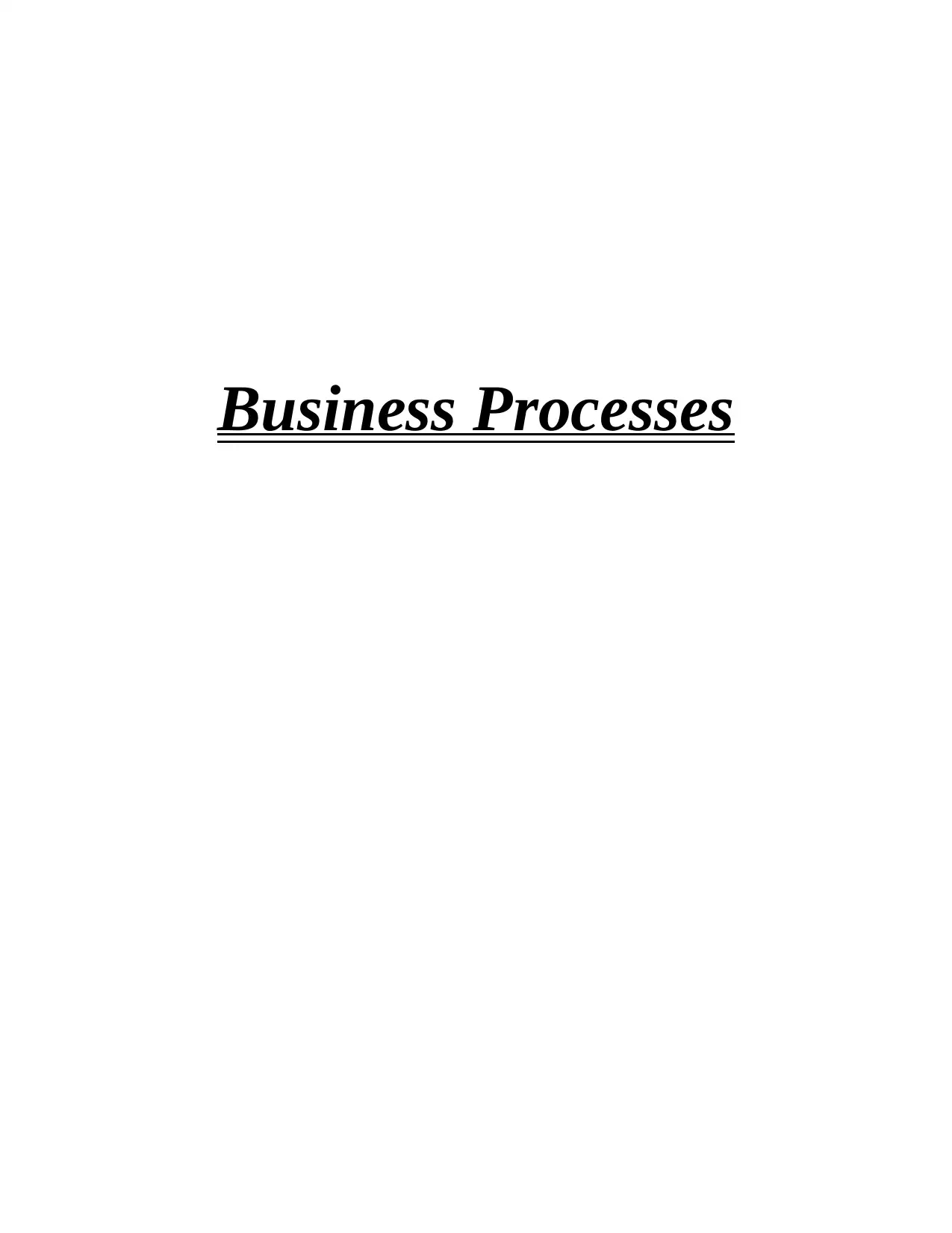
Business Processes
Secure Best Marks with AI Grader
Need help grading? Try our AI Grader for instant feedback on your assignments.
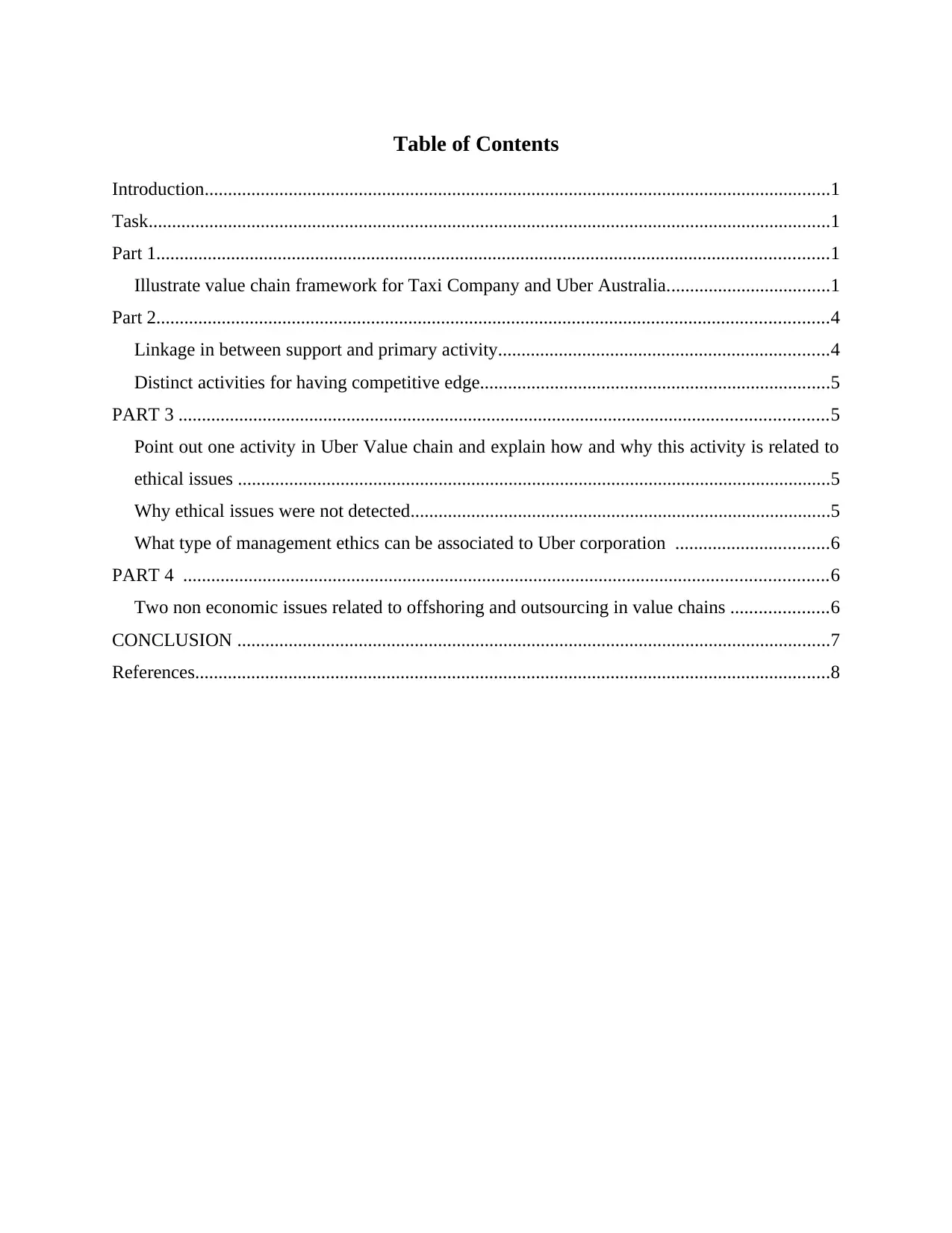
Table of Contents
Introduction......................................................................................................................................1
Task..................................................................................................................................................1
Part 1................................................................................................................................................1
Illustrate value chain framework for Taxi Company and Uber Australia...................................1
Part 2................................................................................................................................................4
Linkage in between support and primary activity.......................................................................4
Distinct activities for having competitive edge...........................................................................5
PART 3 ...........................................................................................................................................5
Point out one activity in Uber Value chain and explain how and why this activity is related to
ethical issues ...............................................................................................................................5
Why ethical issues were not detected..........................................................................................5
What type of management ethics can be associated to Uber corporation .................................6
PART 4 ..........................................................................................................................................6
Two non economic issues related to offshoring and outsourcing in value chains .....................6
CONCLUSION ...............................................................................................................................7
References........................................................................................................................................8
Introduction......................................................................................................................................1
Task..................................................................................................................................................1
Part 1................................................................................................................................................1
Illustrate value chain framework for Taxi Company and Uber Australia...................................1
Part 2................................................................................................................................................4
Linkage in between support and primary activity.......................................................................4
Distinct activities for having competitive edge...........................................................................5
PART 3 ...........................................................................................................................................5
Point out one activity in Uber Value chain and explain how and why this activity is related to
ethical issues ...............................................................................................................................5
Why ethical issues were not detected..........................................................................................5
What type of management ethics can be associated to Uber corporation .................................6
PART 4 ..........................................................................................................................................6
Two non economic issues related to offshoring and outsourcing in value chains .....................6
CONCLUSION ...............................................................................................................................7
References........................................................................................................................................8
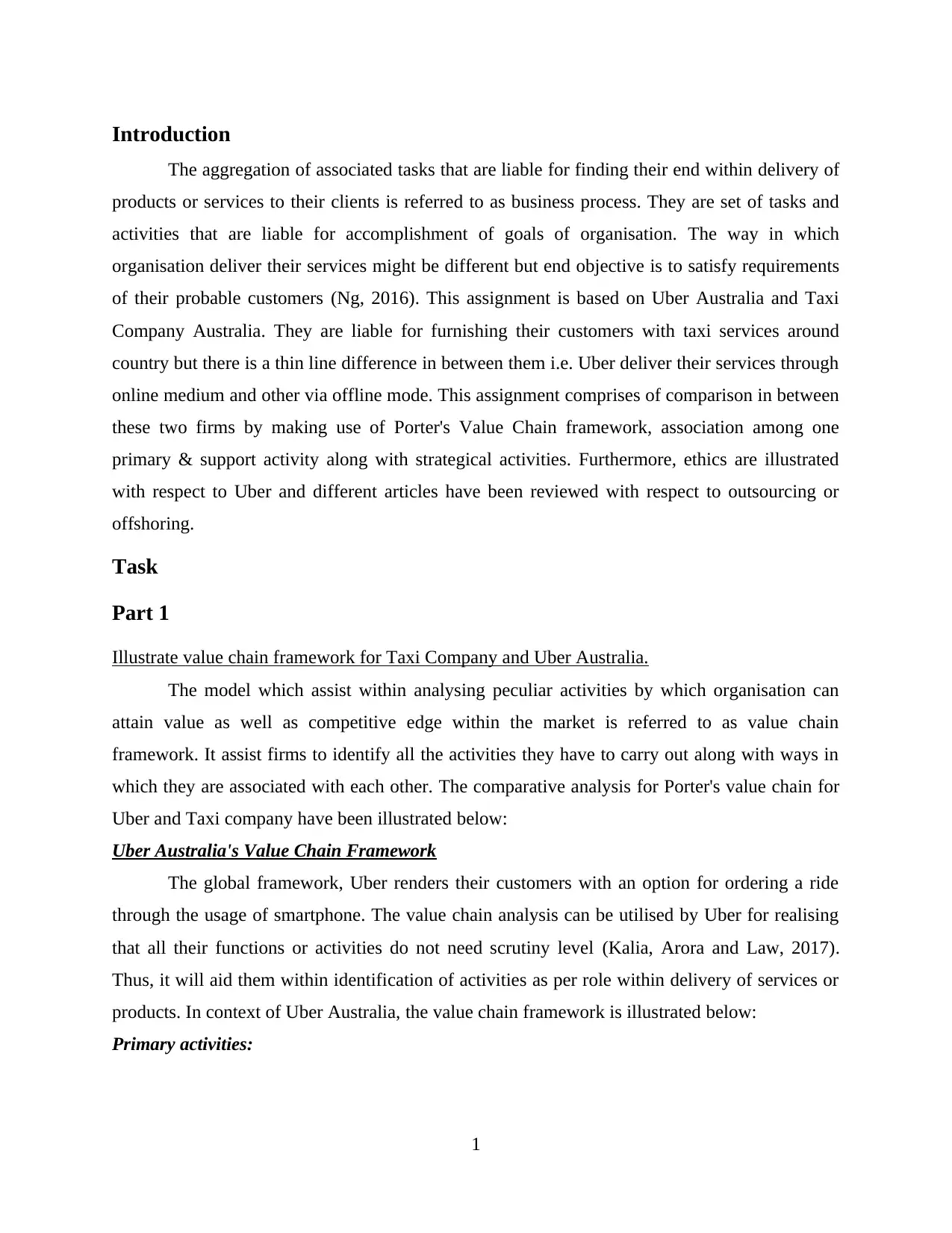
Introduction
The aggregation of associated tasks that are liable for finding their end within delivery of
products or services to their clients is referred to as business process. They are set of tasks and
activities that are liable for accomplishment of goals of organisation. The way in which
organisation deliver their services might be different but end objective is to satisfy requirements
of their probable customers (Ng, 2016). This assignment is based on Uber Australia and Taxi
Company Australia. They are liable for furnishing their customers with taxi services around
country but there is a thin line difference in between them i.e. Uber deliver their services through
online medium and other via offline mode. This assignment comprises of comparison in between
these two firms by making use of Porter's Value Chain framework, association among one
primary & support activity along with strategical activities. Furthermore, ethics are illustrated
with respect to Uber and different articles have been reviewed with respect to outsourcing or
offshoring.
Task
Part 1
Illustrate value chain framework for Taxi Company and Uber Australia.
The model which assist within analysing peculiar activities by which organisation can
attain value as well as competitive edge within the market is referred to as value chain
framework. It assist firms to identify all the activities they have to carry out along with ways in
which they are associated with each other. The comparative analysis for Porter's value chain for
Uber and Taxi company have been illustrated below:
Uber Australia's Value Chain Framework
The global framework, Uber renders their customers with an option for ordering a ride
through the usage of smartphone. The value chain analysis can be utilised by Uber for realising
that all their functions or activities do not need scrutiny level (Kalia, Arora and Law, 2017).
Thus, it will aid them within identification of activities as per role within delivery of services or
products. In context of Uber Australia, the value chain framework is illustrated below:
Primary activities:
1
The aggregation of associated tasks that are liable for finding their end within delivery of
products or services to their clients is referred to as business process. They are set of tasks and
activities that are liable for accomplishment of goals of organisation. The way in which
organisation deliver their services might be different but end objective is to satisfy requirements
of their probable customers (Ng, 2016). This assignment is based on Uber Australia and Taxi
Company Australia. They are liable for furnishing their customers with taxi services around
country but there is a thin line difference in between them i.e. Uber deliver their services through
online medium and other via offline mode. This assignment comprises of comparison in between
these two firms by making use of Porter's Value Chain framework, association among one
primary & support activity along with strategical activities. Furthermore, ethics are illustrated
with respect to Uber and different articles have been reviewed with respect to outsourcing or
offshoring.
Task
Part 1
Illustrate value chain framework for Taxi Company and Uber Australia.
The model which assist within analysing peculiar activities by which organisation can
attain value as well as competitive edge within the market is referred to as value chain
framework. It assist firms to identify all the activities they have to carry out along with ways in
which they are associated with each other. The comparative analysis for Porter's value chain for
Uber and Taxi company have been illustrated below:
Uber Australia's Value Chain Framework
The global framework, Uber renders their customers with an option for ordering a ride
through the usage of smartphone. The value chain analysis can be utilised by Uber for realising
that all their functions or activities do not need scrutiny level (Kalia, Arora and Law, 2017).
Thus, it will aid them within identification of activities as per role within delivery of services or
products. In context of Uber Australia, the value chain framework is illustrated below:
Primary activities:
1
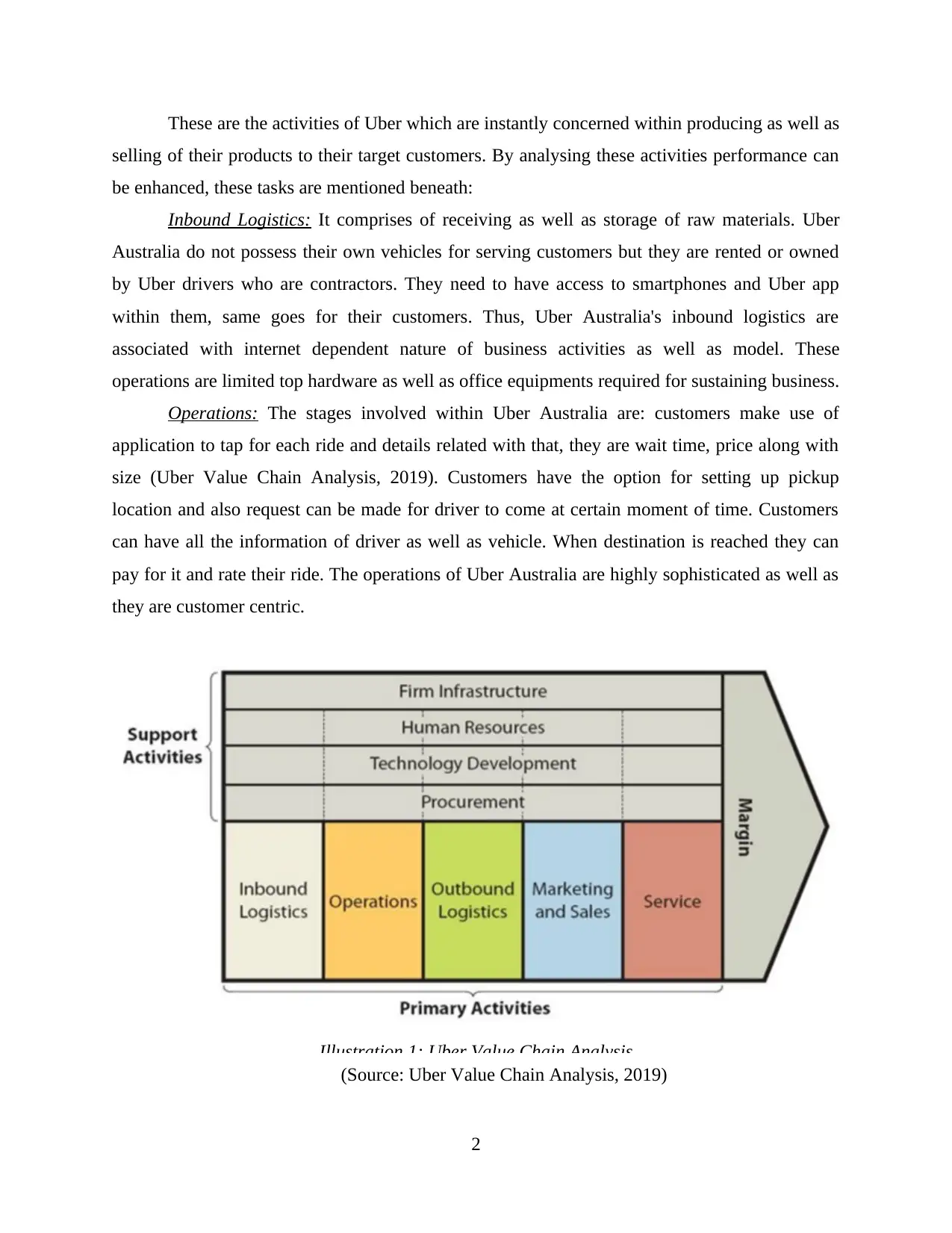
These are the activities of Uber which are instantly concerned within producing as well as
selling of their products to their target customers. By analysing these activities performance can
be enhanced, these tasks are mentioned beneath:
Inbound Logistics: It comprises of receiving as well as storage of raw materials. Uber
Australia do not possess their own vehicles for serving customers but they are rented or owned
by Uber drivers who are contractors. They need to have access to smartphones and Uber app
within them, same goes for their customers. Thus, Uber Australia's inbound logistics are
associated with internet dependent nature of business activities as well as model. These
operations are limited top hardware as well as office equipments required for sustaining business.
Operations: The stages involved within Uber Australia are: customers make use of
application to tap for each ride and details related with that, they are wait time, price along with
size (Uber Value Chain Analysis, 2019). Customers have the option for setting up pickup
location and also request can be made for driver to come at certain moment of time. Customers
can have all the information of driver as well as vehicle. When destination is reached they can
pay for it and rate their ride. The operations of Uber Australia are highly sophisticated as well as
they are customer centric.
(Source: Uber Value Chain Analysis, 2019)
2
Illustration 1: Uber Value Chain Analysis
selling of their products to their target customers. By analysing these activities performance can
be enhanced, these tasks are mentioned beneath:
Inbound Logistics: It comprises of receiving as well as storage of raw materials. Uber
Australia do not possess their own vehicles for serving customers but they are rented or owned
by Uber drivers who are contractors. They need to have access to smartphones and Uber app
within them, same goes for their customers. Thus, Uber Australia's inbound logistics are
associated with internet dependent nature of business activities as well as model. These
operations are limited top hardware as well as office equipments required for sustaining business.
Operations: The stages involved within Uber Australia are: customers make use of
application to tap for each ride and details related with that, they are wait time, price along with
size (Uber Value Chain Analysis, 2019). Customers have the option for setting up pickup
location and also request can be made for driver to come at certain moment of time. Customers
can have all the information of driver as well as vehicle. When destination is reached they can
pay for it and rate their ride. The operations of Uber Australia are highly sophisticated as well as
they are customer centric.
(Source: Uber Value Chain Analysis, 2019)
2
Illustration 1: Uber Value Chain Analysis
Secure Best Marks with AI Grader
Need help grading? Try our AI Grader for instant feedback on your assignments.
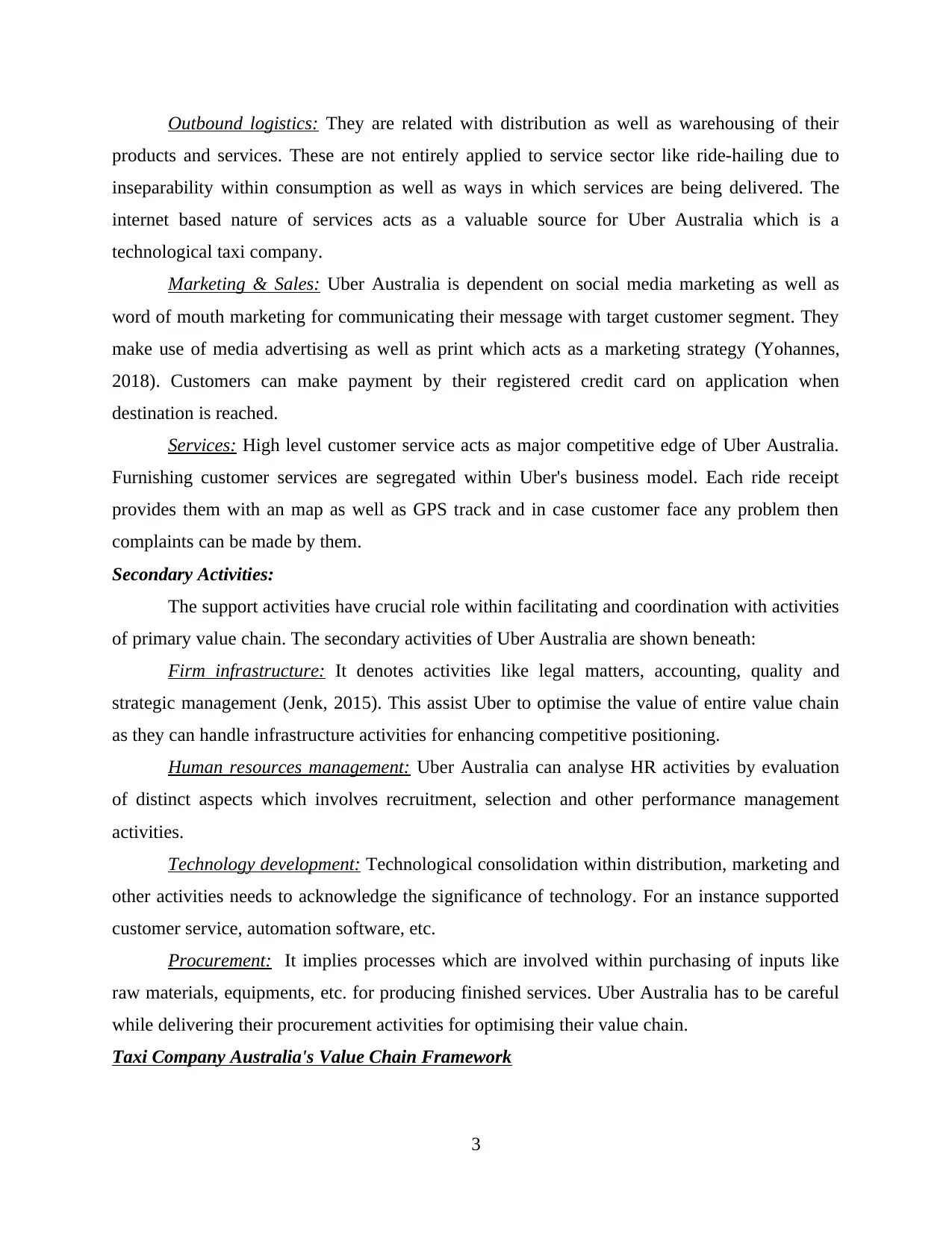
Outbound logistics: They are related with distribution as well as warehousing of their
products and services. These are not entirely applied to service sector like ride-hailing due to
inseparability within consumption as well as ways in which services are being delivered. The
internet based nature of services acts as a valuable source for Uber Australia which is a
technological taxi company.
Marketing & Sales: Uber Australia is dependent on social media marketing as well as
word of mouth marketing for communicating their message with target customer segment. They
make use of media advertising as well as print which acts as a marketing strategy (Yohannes,
2018). Customers can make payment by their registered credit card on application when
destination is reached.
Services: High level customer service acts as major competitive edge of Uber Australia.
Furnishing customer services are segregated within Uber's business model. Each ride receipt
provides them with an map as well as GPS track and in case customer face any problem then
complaints can be made by them.
Secondary Activities:
The support activities have crucial role within facilitating and coordination with activities
of primary value chain. The secondary activities of Uber Australia are shown beneath:
Firm infrastructure: It denotes activities like legal matters, accounting, quality and
strategic management (Jenk, 2015). This assist Uber to optimise the value of entire value chain
as they can handle infrastructure activities for enhancing competitive positioning.
Human resources management: Uber Australia can analyse HR activities by evaluation
of distinct aspects which involves recruitment, selection and other performance management
activities.
Technology development: Technological consolidation within distribution, marketing and
other activities needs to acknowledge the significance of technology. For an instance supported
customer service, automation software, etc.
Procurement: It implies processes which are involved within purchasing of inputs like
raw materials, equipments, etc. for producing finished services. Uber Australia has to be careful
while delivering their procurement activities for optimising their value chain.
Taxi Company Australia's Value Chain Framework
3
products and services. These are not entirely applied to service sector like ride-hailing due to
inseparability within consumption as well as ways in which services are being delivered. The
internet based nature of services acts as a valuable source for Uber Australia which is a
technological taxi company.
Marketing & Sales: Uber Australia is dependent on social media marketing as well as
word of mouth marketing for communicating their message with target customer segment. They
make use of media advertising as well as print which acts as a marketing strategy (Yohannes,
2018). Customers can make payment by their registered credit card on application when
destination is reached.
Services: High level customer service acts as major competitive edge of Uber Australia.
Furnishing customer services are segregated within Uber's business model. Each ride receipt
provides them with an map as well as GPS track and in case customer face any problem then
complaints can be made by them.
Secondary Activities:
The support activities have crucial role within facilitating and coordination with activities
of primary value chain. The secondary activities of Uber Australia are shown beneath:
Firm infrastructure: It denotes activities like legal matters, accounting, quality and
strategic management (Jenk, 2015). This assist Uber to optimise the value of entire value chain
as they can handle infrastructure activities for enhancing competitive positioning.
Human resources management: Uber Australia can analyse HR activities by evaluation
of distinct aspects which involves recruitment, selection and other performance management
activities.
Technology development: Technological consolidation within distribution, marketing and
other activities needs to acknowledge the significance of technology. For an instance supported
customer service, automation software, etc.
Procurement: It implies processes which are involved within purchasing of inputs like
raw materials, equipments, etc. for producing finished services. Uber Australia has to be careful
while delivering their procurement activities for optimising their value chain.
Taxi Company Australia's Value Chain Framework
3
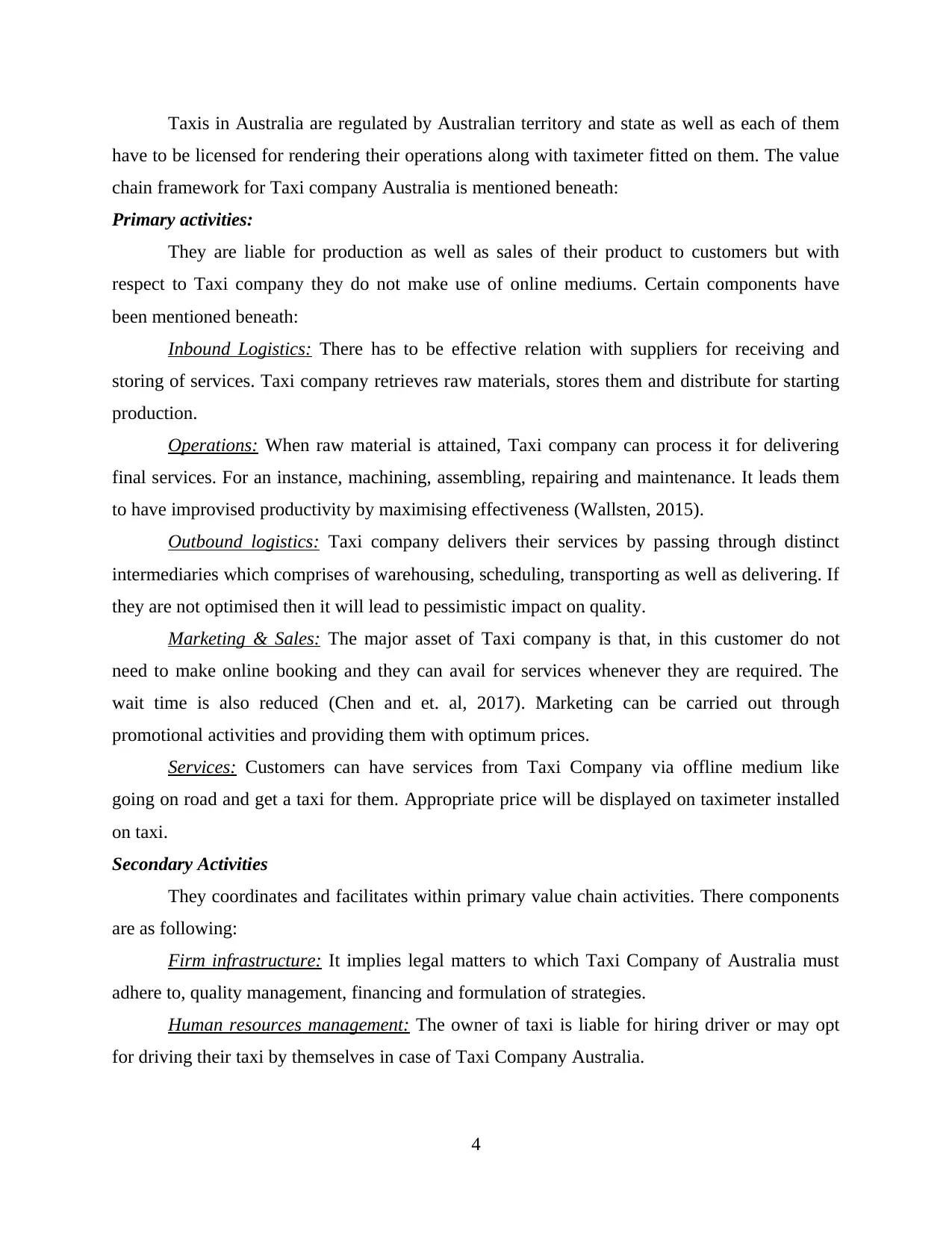
Taxis in Australia are regulated by Australian territory and state as well as each of them
have to be licensed for rendering their operations along with taximeter fitted on them. The value
chain framework for Taxi company Australia is mentioned beneath:
Primary activities:
They are liable for production as well as sales of their product to customers but with
respect to Taxi company they do not make use of online mediums. Certain components have
been mentioned beneath:
Inbound Logistics: There has to be effective relation with suppliers for receiving and
storing of services. Taxi company retrieves raw materials, stores them and distribute for starting
production.
Operations: When raw material is attained, Taxi company can process it for delivering
final services. For an instance, machining, assembling, repairing and maintenance. It leads them
to have improvised productivity by maximising effectiveness (Wallsten, 2015).
Outbound logistics: Taxi company delivers their services by passing through distinct
intermediaries which comprises of warehousing, scheduling, transporting as well as delivering. If
they are not optimised then it will lead to pessimistic impact on quality.
Marketing & Sales: The major asset of Taxi company is that, in this customer do not
need to make online booking and they can avail for services whenever they are required. The
wait time is also reduced (Chen and et. al, 2017). Marketing can be carried out through
promotional activities and providing them with optimum prices.
Services: Customers can have services from Taxi Company via offline medium like
going on road and get a taxi for them. Appropriate price will be displayed on taximeter installed
on taxi.
Secondary Activities
They coordinates and facilitates within primary value chain activities. There components
are as following:
Firm infrastructure: It implies legal matters to which Taxi Company of Australia must
adhere to, quality management, financing and formulation of strategies.
Human resources management: The owner of taxi is liable for hiring driver or may opt
for driving their taxi by themselves in case of Taxi Company Australia.
4
have to be licensed for rendering their operations along with taximeter fitted on them. The value
chain framework for Taxi company Australia is mentioned beneath:
Primary activities:
They are liable for production as well as sales of their product to customers but with
respect to Taxi company they do not make use of online mediums. Certain components have
been mentioned beneath:
Inbound Logistics: There has to be effective relation with suppliers for receiving and
storing of services. Taxi company retrieves raw materials, stores them and distribute for starting
production.
Operations: When raw material is attained, Taxi company can process it for delivering
final services. For an instance, machining, assembling, repairing and maintenance. It leads them
to have improvised productivity by maximising effectiveness (Wallsten, 2015).
Outbound logistics: Taxi company delivers their services by passing through distinct
intermediaries which comprises of warehousing, scheduling, transporting as well as delivering. If
they are not optimised then it will lead to pessimistic impact on quality.
Marketing & Sales: The major asset of Taxi company is that, in this customer do not
need to make online booking and they can avail for services whenever they are required. The
wait time is also reduced (Chen and et. al, 2017). Marketing can be carried out through
promotional activities and providing them with optimum prices.
Services: Customers can have services from Taxi Company via offline medium like
going on road and get a taxi for them. Appropriate price will be displayed on taximeter installed
on taxi.
Secondary Activities
They coordinates and facilitates within primary value chain activities. There components
are as following:
Firm infrastructure: It implies legal matters to which Taxi Company of Australia must
adhere to, quality management, financing and formulation of strategies.
Human resources management: The owner of taxi is liable for hiring driver or may opt
for driving their taxi by themselves in case of Taxi Company Australia.
4
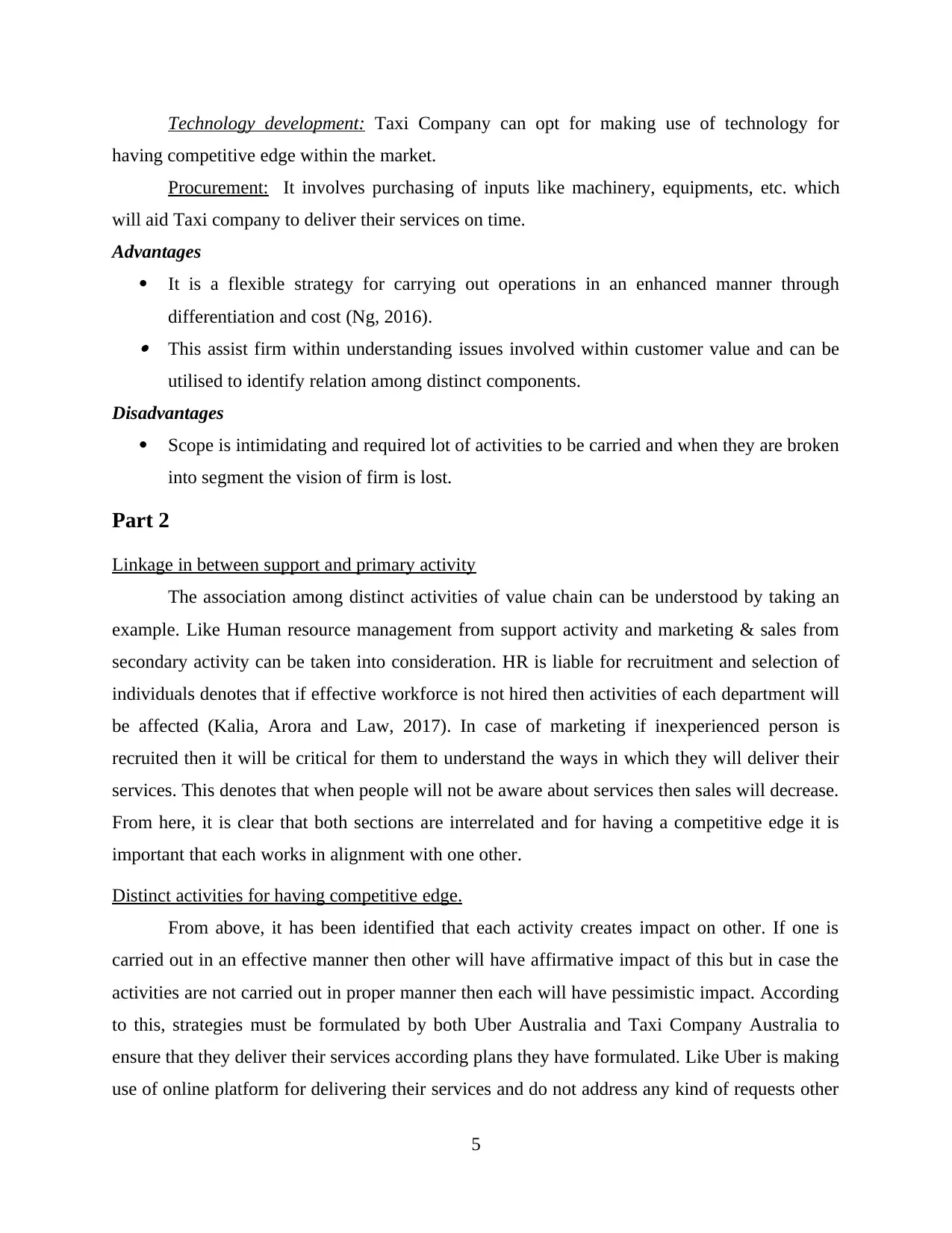
Technology development: Taxi Company can opt for making use of technology for
having competitive edge within the market.
Procurement: It involves purchasing of inputs like machinery, equipments, etc. which
will aid Taxi company to deliver their services on time.
Advantages
It is a flexible strategy for carrying out operations in an enhanced manner through
differentiation and cost (Ng, 2016). This assist firm within understanding issues involved within customer value and can be
utilised to identify relation among distinct components.
Disadvantages
Scope is intimidating and required lot of activities to be carried and when they are broken
into segment the vision of firm is lost.
Part 2
Linkage in between support and primary activity
The association among distinct activities of value chain can be understood by taking an
example. Like Human resource management from support activity and marketing & sales from
secondary activity can be taken into consideration. HR is liable for recruitment and selection of
individuals denotes that if effective workforce is not hired then activities of each department will
be affected (Kalia, Arora and Law, 2017). In case of marketing if inexperienced person is
recruited then it will be critical for them to understand the ways in which they will deliver their
services. This denotes that when people will not be aware about services then sales will decrease.
From here, it is clear that both sections are interrelated and for having a competitive edge it is
important that each works in alignment with one other.
Distinct activities for having competitive edge.
From above, it has been identified that each activity creates impact on other. If one is
carried out in an effective manner then other will have affirmative impact of this but in case the
activities are not carried out in proper manner then each will have pessimistic impact. According
to this, strategies must be formulated by both Uber Australia and Taxi Company Australia to
ensure that they deliver their services according plans they have formulated. Like Uber is making
use of online platform for delivering their services and do not address any kind of requests other
5
having competitive edge within the market.
Procurement: It involves purchasing of inputs like machinery, equipments, etc. which
will aid Taxi company to deliver their services on time.
Advantages
It is a flexible strategy for carrying out operations in an enhanced manner through
differentiation and cost (Ng, 2016). This assist firm within understanding issues involved within customer value and can be
utilised to identify relation among distinct components.
Disadvantages
Scope is intimidating and required lot of activities to be carried and when they are broken
into segment the vision of firm is lost.
Part 2
Linkage in between support and primary activity
The association among distinct activities of value chain can be understood by taking an
example. Like Human resource management from support activity and marketing & sales from
secondary activity can be taken into consideration. HR is liable for recruitment and selection of
individuals denotes that if effective workforce is not hired then activities of each department will
be affected (Kalia, Arora and Law, 2017). In case of marketing if inexperienced person is
recruited then it will be critical for them to understand the ways in which they will deliver their
services. This denotes that when people will not be aware about services then sales will decrease.
From here, it is clear that both sections are interrelated and for having a competitive edge it is
important that each works in alignment with one other.
Distinct activities for having competitive edge.
From above, it has been identified that each activity creates impact on other. If one is
carried out in an effective manner then other will have affirmative impact of this but in case the
activities are not carried out in proper manner then each will have pessimistic impact. According
to this, strategies must be formulated by both Uber Australia and Taxi Company Australia to
ensure that they deliver their services according plans they have formulated. Like Uber is making
use of online platform for delivering their services and do not address any kind of requests other
5
Paraphrase This Document
Need a fresh take? Get an instant paraphrase of this document with our AI Paraphraser
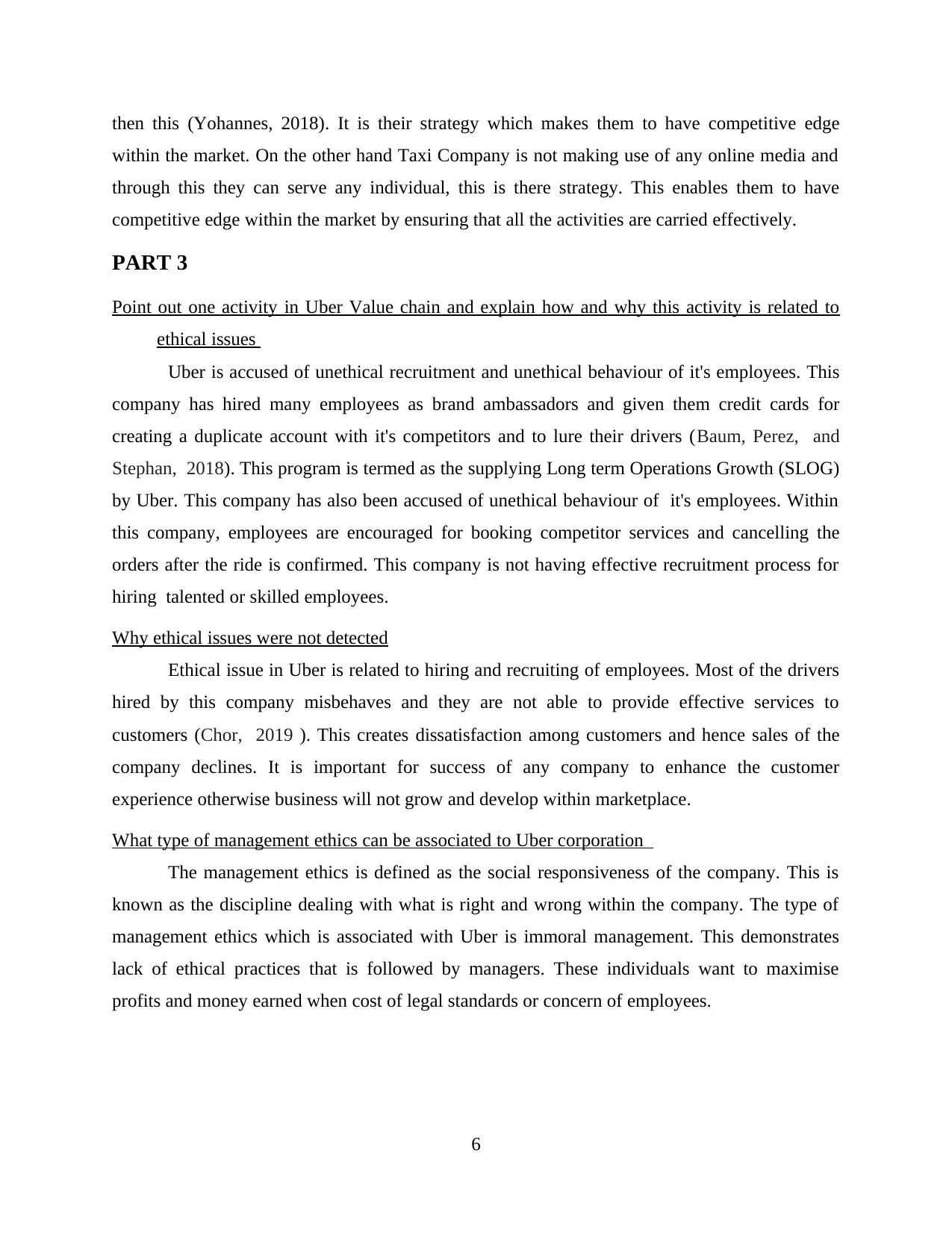
then this (Yohannes, 2018). It is their strategy which makes them to have competitive edge
within the market. On the other hand Taxi Company is not making use of any online media and
through this they can serve any individual, this is there strategy. This enables them to have
competitive edge within the market by ensuring that all the activities are carried effectively.
PART 3
Point out one activity in Uber Value chain and explain how and why this activity is related to
ethical issues
Uber is accused of unethical recruitment and unethical behaviour of it's employees. This
company has hired many employees as brand ambassadors and given them credit cards for
creating a duplicate account with it's competitors and to lure their drivers (Baum, Perez, and
Stephan, 2018). This program is termed as the supplying Long term Operations Growth (SLOG)
by Uber. This company has also been accused of unethical behaviour of it's employees. Within
this company, employees are encouraged for booking competitor services and cancelling the
orders after the ride is confirmed. This company is not having effective recruitment process for
hiring talented or skilled employees.
Why ethical issues were not detected
Ethical issue in Uber is related to hiring and recruiting of employees. Most of the drivers
hired by this company misbehaves and they are not able to provide effective services to
customers (Chor, 2019 ). This creates dissatisfaction among customers and hence sales of the
company declines. It is important for success of any company to enhance the customer
experience otherwise business will not grow and develop within marketplace.
What type of management ethics can be associated to Uber corporation
The management ethics is defined as the social responsiveness of the company. This is
known as the discipline dealing with what is right and wrong within the company. The type of
management ethics which is associated with Uber is immoral management. This demonstrates
lack of ethical practices that is followed by managers. These individuals want to maximise
profits and money earned when cost of legal standards or concern of employees.
6
within the market. On the other hand Taxi Company is not making use of any online media and
through this they can serve any individual, this is there strategy. This enables them to have
competitive edge within the market by ensuring that all the activities are carried effectively.
PART 3
Point out one activity in Uber Value chain and explain how and why this activity is related to
ethical issues
Uber is accused of unethical recruitment and unethical behaviour of it's employees. This
company has hired many employees as brand ambassadors and given them credit cards for
creating a duplicate account with it's competitors and to lure their drivers (Baum, Perez, and
Stephan, 2018). This program is termed as the supplying Long term Operations Growth (SLOG)
by Uber. This company has also been accused of unethical behaviour of it's employees. Within
this company, employees are encouraged for booking competitor services and cancelling the
orders after the ride is confirmed. This company is not having effective recruitment process for
hiring talented or skilled employees.
Why ethical issues were not detected
Ethical issue in Uber is related to hiring and recruiting of employees. Most of the drivers
hired by this company misbehaves and they are not able to provide effective services to
customers (Chor, 2019 ). This creates dissatisfaction among customers and hence sales of the
company declines. It is important for success of any company to enhance the customer
experience otherwise business will not grow and develop within marketplace.
What type of management ethics can be associated to Uber corporation
The management ethics is defined as the social responsiveness of the company. This is
known as the discipline dealing with what is right and wrong within the company. The type of
management ethics which is associated with Uber is immoral management. This demonstrates
lack of ethical practices that is followed by managers. These individuals want to maximise
profits and money earned when cost of legal standards or concern of employees.
6
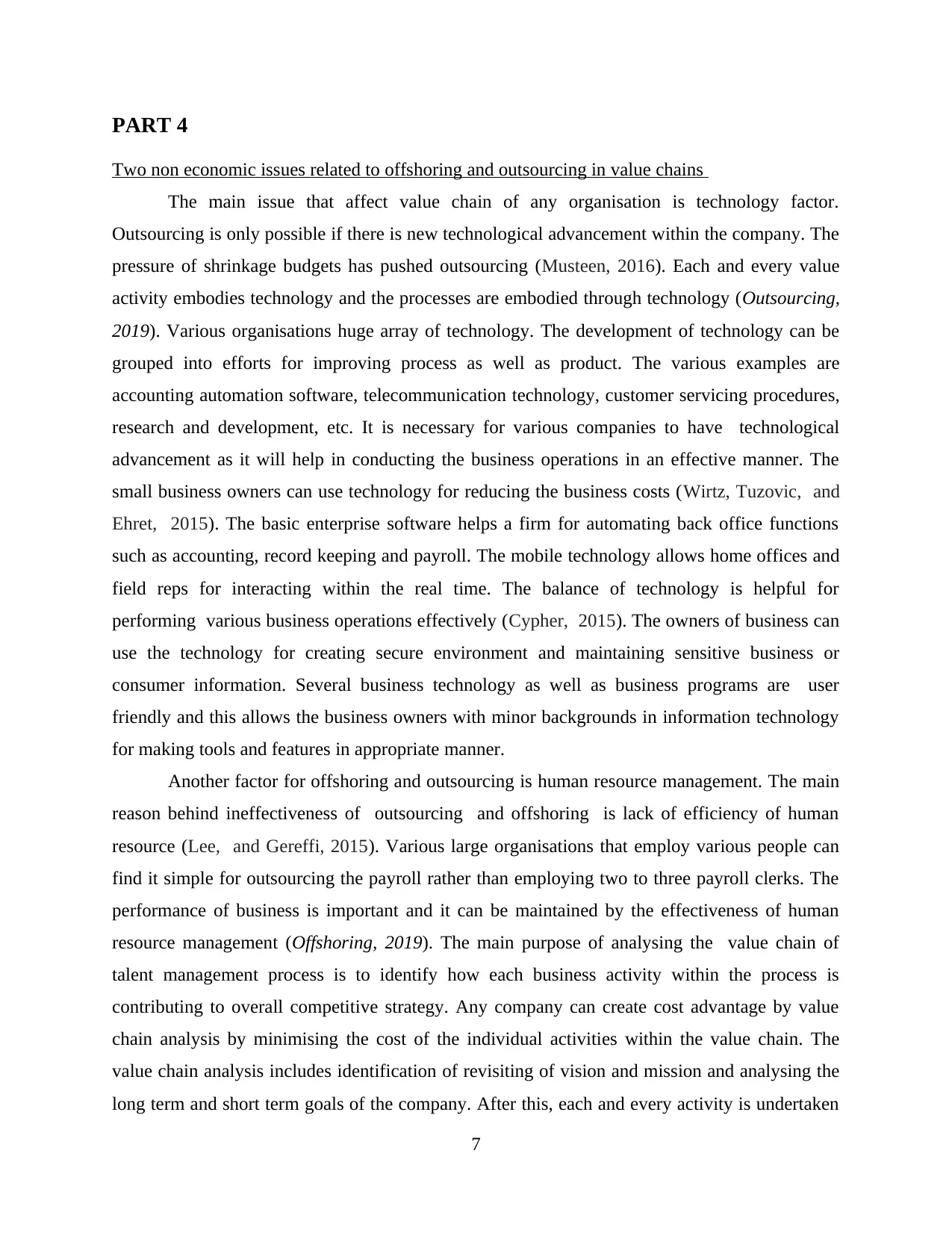
PART 4
Two non economic issues related to offshoring and outsourcing in value chains
The main issue that affect value chain of any organisation is technology factor.
Outsourcing is only possible if there is new technological advancement within the company. The
pressure of shrinkage budgets has pushed outsourcing (Musteen, 2016). Each and every value
activity embodies technology and the processes are embodied through technology (Outsourcing,
2019). Various organisations huge array of technology. The development of technology can be
grouped into efforts for improving process as well as product. The various examples are
accounting automation software, telecommunication technology, customer servicing procedures,
research and development, etc. It is necessary for various companies to have technological
advancement as it will help in conducting the business operations in an effective manner. The
small business owners can use technology for reducing the business costs (Wirtz, Tuzovic, and
Ehret, 2015). The basic enterprise software helps a firm for automating back office functions
such as accounting, record keeping and payroll. The mobile technology allows home offices and
field reps for interacting within the real time. The balance of technology is helpful for
performing various business operations effectively (Cypher, 2015). The owners of business can
use the technology for creating secure environment and maintaining sensitive business or
consumer information. Several business technology as well as business programs are user
friendly and this allows the business owners with minor backgrounds in information technology
for making tools and features in appropriate manner.
Another factor for offshoring and outsourcing is human resource management. The main
reason behind ineffectiveness of outsourcing and offshoring is lack of efficiency of human
resource (Lee, and Gereffi, 2015). Various large organisations that employ various people can
find it simple for outsourcing the payroll rather than employing two to three payroll clerks. The
performance of business is important and it can be maintained by the effectiveness of human
resource management (Offshoring, 2019). The main purpose of analysing the value chain of
talent management process is to identify how each business activity within the process is
contributing to overall competitive strategy. Any company can create cost advantage by value
chain analysis by minimising the cost of the individual activities within the value chain. The
value chain analysis includes identification of revisiting of vision and mission and analysing the
long term and short term goals of the company. After this, each and every activity is undertaken
7
Two non economic issues related to offshoring and outsourcing in value chains
The main issue that affect value chain of any organisation is technology factor.
Outsourcing is only possible if there is new technological advancement within the company. The
pressure of shrinkage budgets has pushed outsourcing (Musteen, 2016). Each and every value
activity embodies technology and the processes are embodied through technology (Outsourcing,
2019). Various organisations huge array of technology. The development of technology can be
grouped into efforts for improving process as well as product. The various examples are
accounting automation software, telecommunication technology, customer servicing procedures,
research and development, etc. It is necessary for various companies to have technological
advancement as it will help in conducting the business operations in an effective manner. The
small business owners can use technology for reducing the business costs (Wirtz, Tuzovic, and
Ehret, 2015). The basic enterprise software helps a firm for automating back office functions
such as accounting, record keeping and payroll. The mobile technology allows home offices and
field reps for interacting within the real time. The balance of technology is helpful for
performing various business operations effectively (Cypher, 2015). The owners of business can
use the technology for creating secure environment and maintaining sensitive business or
consumer information. Several business technology as well as business programs are user
friendly and this allows the business owners with minor backgrounds in information technology
for making tools and features in appropriate manner.
Another factor for offshoring and outsourcing is human resource management. The main
reason behind ineffectiveness of outsourcing and offshoring is lack of efficiency of human
resource (Lee, and Gereffi, 2015). Various large organisations that employ various people can
find it simple for outsourcing the payroll rather than employing two to three payroll clerks. The
performance of business is important and it can be maintained by the effectiveness of human
resource management (Offshoring, 2019). The main purpose of analysing the value chain of
talent management process is to identify how each business activity within the process is
contributing to overall competitive strategy. Any company can create cost advantage by value
chain analysis by minimising the cost of the individual activities within the value chain. The
value chain analysis includes identification of revisiting of vision and mission and analysing the
long term and short term goals of the company. After this, each and every activity is undertaken
7
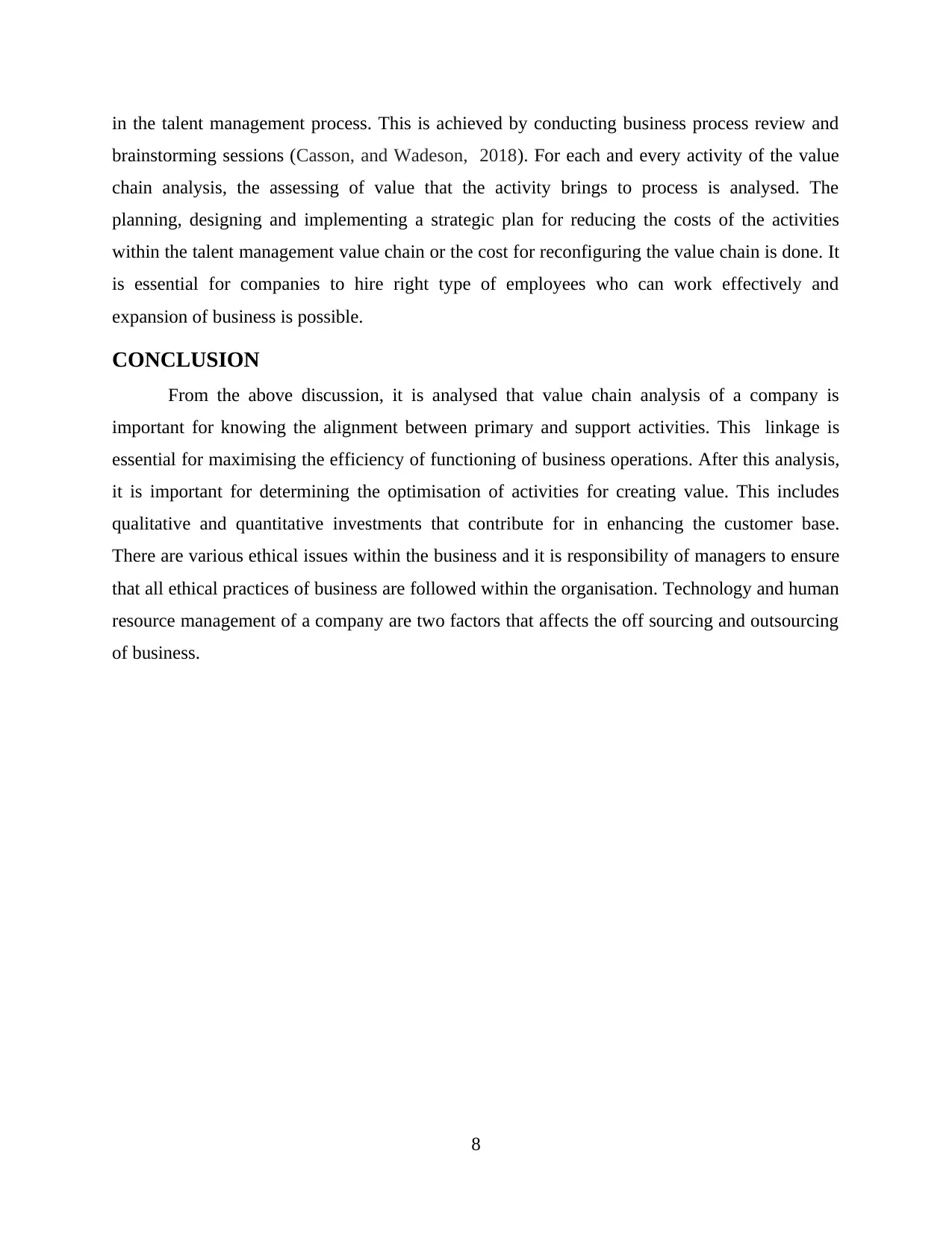
in the talent management process. This is achieved by conducting business process review and
brainstorming sessions (Casson, and Wadeson, 2018). For each and every activity of the value
chain analysis, the assessing of value that the activity brings to process is analysed. The
planning, designing and implementing a strategic plan for reducing the costs of the activities
within the talent management value chain or the cost for reconfiguring the value chain is done. It
is essential for companies to hire right type of employees who can work effectively and
expansion of business is possible.
CONCLUSION
From the above discussion, it is analysed that value chain analysis of a company is
important for knowing the alignment between primary and support activities. This linkage is
essential for maximising the efficiency of functioning of business operations. After this analysis,
it is important for determining the optimisation of activities for creating value. This includes
qualitative and quantitative investments that contribute for in enhancing the customer base.
There are various ethical issues within the business and it is responsibility of managers to ensure
that all ethical practices of business are followed within the organisation. Technology and human
resource management of a company are two factors that affects the off sourcing and outsourcing
of business.
8
brainstorming sessions (Casson, and Wadeson, 2018). For each and every activity of the value
chain analysis, the assessing of value that the activity brings to process is analysed. The
planning, designing and implementing a strategic plan for reducing the costs of the activities
within the talent management value chain or the cost for reconfiguring the value chain is done. It
is essential for companies to hire right type of employees who can work effectively and
expansion of business is possible.
CONCLUSION
From the above discussion, it is analysed that value chain analysis of a company is
important for knowing the alignment between primary and support activities. This linkage is
essential for maximising the efficiency of functioning of business operations. After this analysis,
it is important for determining the optimisation of activities for creating value. This includes
qualitative and quantitative investments that contribute for in enhancing the customer base.
There are various ethical issues within the business and it is responsibility of managers to ensure
that all ethical practices of business are followed within the organisation. Technology and human
resource management of a company are two factors that affects the off sourcing and outsourcing
of business.
8
Secure Best Marks with AI Grader
Need help grading? Try our AI Grader for instant feedback on your assignments.
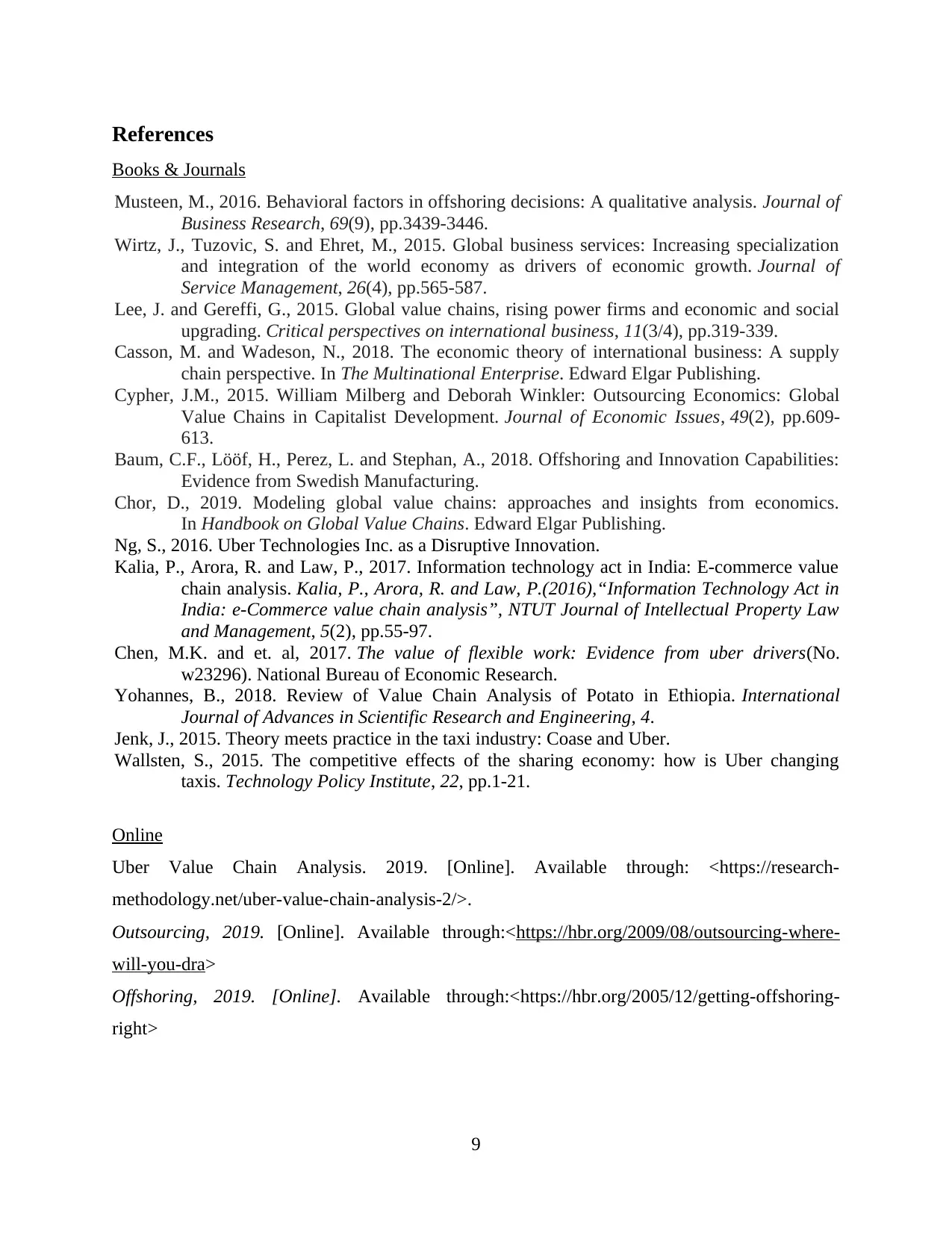
References
Books & Journals
Musteen, M., 2016. Behavioral factors in offshoring decisions: A qualitative analysis. Journal of
Business Research, 69(9), pp.3439-3446.
Wirtz, J., Tuzovic, S. and Ehret, M., 2015. Global business services: Increasing specialization
and integration of the world economy as drivers of economic growth. Journal of
Service Management, 26(4), pp.565-587.
Lee, J. and Gereffi, G., 2015. Global value chains, rising power firms and economic and social
upgrading. Critical perspectives on international business, 11(3/4), pp.319-339.
Casson, M. and Wadeson, N., 2018. The economic theory of international business: A supply
chain perspective. In The Multinational Enterprise. Edward Elgar Publishing.
Cypher, J.M., 2015. William Milberg and Deborah Winkler: Outsourcing Economics: Global
Value Chains in Capitalist Development. Journal of Economic Issues, 49(2), pp.609-
613.
Baum, C.F., Lööf, H., Perez, L. and Stephan, A., 2018. Offshoring and Innovation Capabilities:
Evidence from Swedish Manufacturing.
Chor, D., 2019. Modeling global value chains: approaches and insights from economics.
In Handbook on Global Value Chains. Edward Elgar Publishing.
Ng, S., 2016. Uber Technologies Inc. as a Disruptive Innovation.
Kalia, P., Arora, R. and Law, P., 2017. Information technology act in India: E-commerce value
chain analysis. Kalia, P., Arora, R. and Law, P.(2016),“Information Technology Act in
India: e-Commerce value chain analysis”, NTUT Journal of Intellectual Property Law
and Management, 5(2), pp.55-97.
Chen, M.K. and et. al, 2017. The value of flexible work: Evidence from uber drivers(No.
w23296). National Bureau of Economic Research.
Yohannes, B., 2018. Review of Value Chain Analysis of Potato in Ethiopia. International
Journal of Advances in Scientific Research and Engineering, 4.
Jenk, J., 2015. Theory meets practice in the taxi industry: Coase and Uber.
Wallsten, S., 2015. The competitive effects of the sharing economy: how is Uber changing
taxis. Technology Policy Institute, 22, pp.1-21.
Online
Uber Value Chain Analysis. 2019. [Online]. Available through: <https://research-
methodology.net/uber-value-chain-analysis-2/>.
Outsourcing, 2019. [Online]. Available through:<https://hbr.org/2009/08/outsourcing-where-
will-you-dra>
Offshoring, 2019. [Online]. Available through:<https://hbr.org/2005/12/getting-offshoring-
right>
9
Books & Journals
Musteen, M., 2016. Behavioral factors in offshoring decisions: A qualitative analysis. Journal of
Business Research, 69(9), pp.3439-3446.
Wirtz, J., Tuzovic, S. and Ehret, M., 2015. Global business services: Increasing specialization
and integration of the world economy as drivers of economic growth. Journal of
Service Management, 26(4), pp.565-587.
Lee, J. and Gereffi, G., 2015. Global value chains, rising power firms and economic and social
upgrading. Critical perspectives on international business, 11(3/4), pp.319-339.
Casson, M. and Wadeson, N., 2018. The economic theory of international business: A supply
chain perspective. In The Multinational Enterprise. Edward Elgar Publishing.
Cypher, J.M., 2015. William Milberg and Deborah Winkler: Outsourcing Economics: Global
Value Chains in Capitalist Development. Journal of Economic Issues, 49(2), pp.609-
613.
Baum, C.F., Lööf, H., Perez, L. and Stephan, A., 2018. Offshoring and Innovation Capabilities:
Evidence from Swedish Manufacturing.
Chor, D., 2019. Modeling global value chains: approaches and insights from economics.
In Handbook on Global Value Chains. Edward Elgar Publishing.
Ng, S., 2016. Uber Technologies Inc. as a Disruptive Innovation.
Kalia, P., Arora, R. and Law, P., 2017. Information technology act in India: E-commerce value
chain analysis. Kalia, P., Arora, R. and Law, P.(2016),“Information Technology Act in
India: e-Commerce value chain analysis”, NTUT Journal of Intellectual Property Law
and Management, 5(2), pp.55-97.
Chen, M.K. and et. al, 2017. The value of flexible work: Evidence from uber drivers(No.
w23296). National Bureau of Economic Research.
Yohannes, B., 2018. Review of Value Chain Analysis of Potato in Ethiopia. International
Journal of Advances in Scientific Research and Engineering, 4.
Jenk, J., 2015. Theory meets practice in the taxi industry: Coase and Uber.
Wallsten, S., 2015. The competitive effects of the sharing economy: how is Uber changing
taxis. Technology Policy Institute, 22, pp.1-21.
Online
Uber Value Chain Analysis. 2019. [Online]. Available through: <https://research-
methodology.net/uber-value-chain-analysis-2/>.
Outsourcing, 2019. [Online]. Available through:<https://hbr.org/2009/08/outsourcing-where-
will-you-dra>
Offshoring, 2019. [Online]. Available through:<https://hbr.org/2005/12/getting-offshoring-
right>
9
1 out of 11
Related Documents
Your All-in-One AI-Powered Toolkit for Academic Success.
+13062052269
info@desklib.com
Available 24*7 on WhatsApp / Email
![[object Object]](/_next/static/media/star-bottom.7253800d.svg)
Unlock your academic potential
© 2024 | Zucol Services PVT LTD | All rights reserved.





